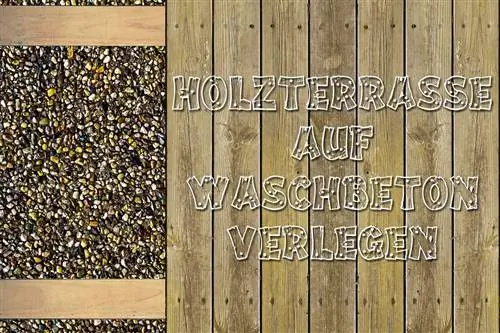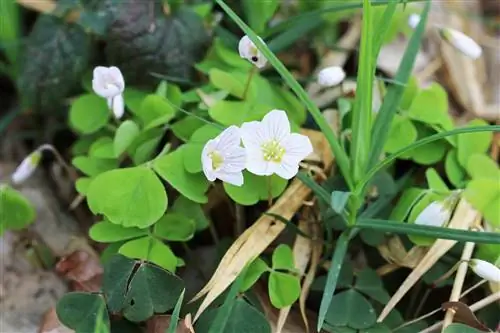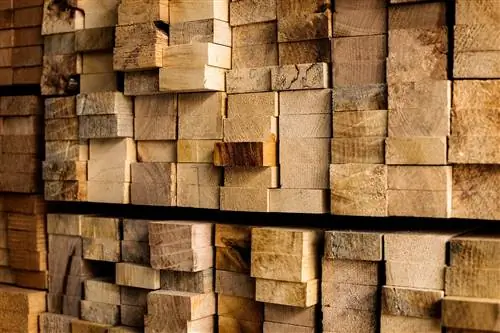- Author admin [email protected].
- Public 2023-12-17 03:39.
- Last modified 2025-01-24 12:45.
For many people, the terrace offers additional living space in the warm season, which they like to use for cozy get-togethers. If you are thinking about covering the floor with a wooden covering, you will find a difficult to manage range of garden wood and corresponding kits in hardware stores and specialist stores.
When choosing a wooden terrace, personal style and taste should not only be the focus, but also robustness and technical properties should be considered. Only then will you make the right choice and enjoy your wooden terrace for a long time.
Individual use determines the choice
Before you decide on the right wood for your terrace, you should think carefully about the conditions. Is the wooden terrace directly exposed to the weather or is it in constant contact with the ground or even water? Then durable types of wood like
- Robinie
- Oak
- Larch
- Douglas fir
- Fir tree
- Pine
suitable. Without additional wood protection measures, these can withstand severe weather stress and remain visually beautiful. If you still want to take appropriate protective measures as a precaution, you can treat the wood with pressure impregnation before laying. So-called constructive wood protection is also recommended, which means that the components for the wooden terrace should be installed in such a way that water is quickly drained away from the surface and the surface is constantly ventilated.
Tropical wood is still popular
Bamboo for wooden terraces is still the classic and very popular in Germany. It not only impresses with its ability to grow back quickly, but also with its visually beautiful color and its extreme stability. The fine grain of the wood always conveys an exotic flair that makes a wooden terrace special. Bangkirai has also now established itself as a popular patio wood. Not only does it withstand moisture and moisture well, but it also impresses with its resistance to fungi and insects. The natural brown tone, which develops a slightly silver patina on the wooden terrace over time, is also very easy to care for.
Dirt can be easily removed with green soap, so you can enjoy your terrace with Bangkirai wood for up to 30 years. Another very popular tropical wood for the terrace is Cumaru, which is particularly impressive due to its enormous longevity of up to 30 years. The look ranges from a yellow tone to a rich reddish brown, which creates a very elegant atmosphere.
When choosing wood, pay attention to the FSC seal
Despite all the positive arguments and beautiful looks, tropical wood continues to polarize. If you want to be on the safe side, you should look for the FSC seal. This term is assigned by the Forest Stewardship Council and ensures sustainable cultivation of tropical wood. The non-profit organization based in Bonn awards this seal to largely free tropical woods from their bad reputation that virgin forests have to be cleared. Apart from that, you should also pay attention to this seal of quality when it comes to local wood. Because many types of wood that are native to this country also grow in other regions that don't take environmental protection very seriously. If you decide to use spruce for your wooden terrace, you cannot be sure without the FSC seal whether the wood comes from Germany or from Russian virgin forests.
Alternative types of wood for terraces
If you prefer local wood for your terrace covering, you can choose larch, for example. This tree is one of the hardest and heaviest natural coniferous woods in all of Europe and has proven itself both in the furniture industry and in its use as a building material. Above all, the weather resistance and excellent stability ensure that larch is a perfect choice for decking. The beautiful look, which has a noble character, ensures that you will feel comfortable on your terrace for more than 15 years.
Somewhat exotic, but not top-notch, is Douglas fir. This robust wood usually comes from western North America or East Asia, but adapts very well to the European climate. Even frequent or intensive contact with water does not affect this wood.
Preparatory planning for terrace construction
If you are thinking about building a terrace out of wood, you not only have to deal with the right choice of wood, but also carry out comprehensive planning. It is very helpful to make an exact drawing of the terrace that shows the exact dimensions and gives a top view. If you also take the distances between the individual boards into account and create the substructure, you can calculate quite accurately how much wood you need to buy. The installation work itself is hardly a problem for hobby craftsmen, but care should be taken in advance
- that the floor is completely flat. This can be corrected by either filling or compacting; a concrete bed is usually not necessary.
- If you want to avoid weeds between the floorboards, you can lay down a root fleece as a base.
- In order to allow the moisture to drain away perfectly, it is recommended that you lay a foundation made of disused stone slabs.
- The supporting beams are then laid on these. There are corresponding bars with a groove that can be purchased ready-made in stores.
- When laying, it is important that a joint with a minimum distance of ten millimeters is left between the wooden boards.
- The wooden terrace is usually laid and screwed together by attaching countersunk wood screws, making sure that the screw head actually sinks completely into the board.
- To ensure that martens, mice or other animals do not nest in the cavity of the terrace, it makes sense to insert fine-meshed rabbit wire here.
What you should know about choosing patio wood in brief
Choosing the right wood and professional installation ensures that the wooden terrace will be used with pleasure and will impress as a visual highlight. Wooden terraces always appear very natural and usually fit very harmoniously into the overall look of the house and garden. You can also walk barefoot on a wooden terrace because this material does not get as hot as a stone terrace, for example.
- However, you have to know that wood is not quite as durable and weather-resistant as a terrace with a stone covering. But if you choose the right wood right from the start, you'll be able to enjoy it for many years to come.
- Not every type of wood is equally suitable for flooring on a terrace. Softwoods, which in the worst case are untreated, have proven to be not particularly good.
- A good example of this is spruce, which is relatively inexpensive but also weathers very quickly. However, these woods can be made more durable through pressure impregnation or heat treatment.
- Hardwoods such as Bangkirai, Douglas fir, teak, eucalyptus and cedar are considered very weather-resistant. Therefore, these are also the preferred woods when it comes to the flooring of a terrace.
When buying these woods, however, you should make sure that they come from controlled cultivation. Unfortunately, a lot of mischief is done with these tropical woods, so you should always make sure that they have a special certificate that shows that they have been grown in a controlled manner.
If you don't want to use tropical wood, you can alternatively use local wood such as larch and pine. Ultimately it is a question of personal taste and also the budget. High-quality woods that are considered to be very durable also have their price. However, you should always keep in mind that you can enjoy it here for ten or twenty years.
- To make your wooden terrace even more durable, you should treat it with a care oil every one to two years.
- You can buy this wherever you can get the appropriate decking boards.
- The oil is simply spread on and additionally protects the wood from weathering.
- You can also usually give the wood a much warmer color.






